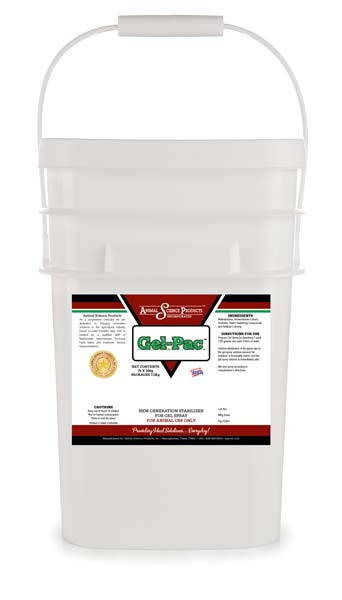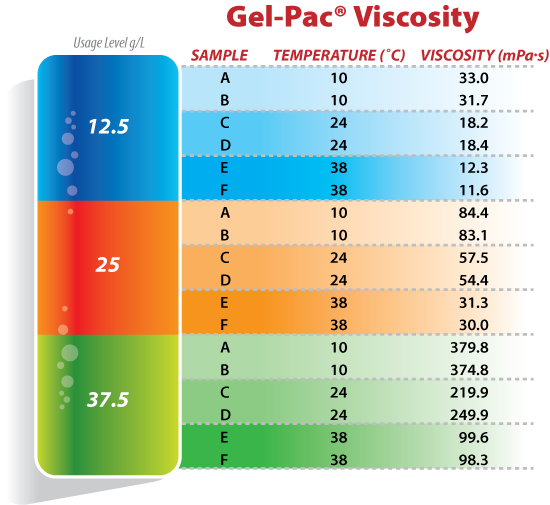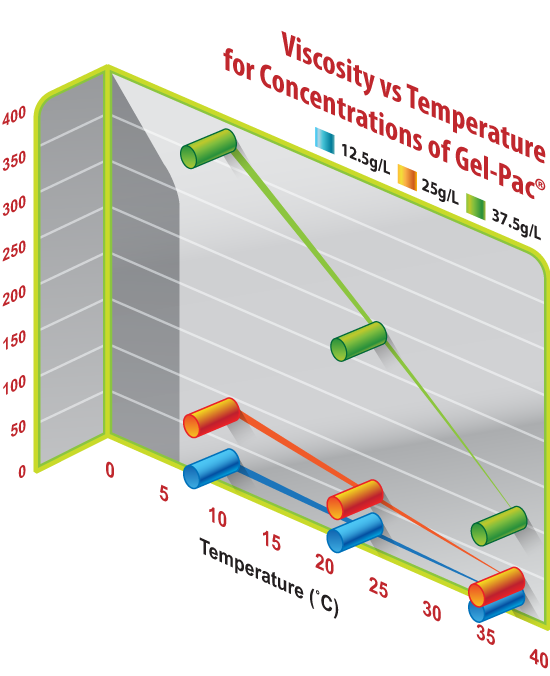
Effects of Concentration and Temperature on the Viscosity of Gel-Pac
PROJECT OBJECTIVE
To determine the effects of concentration and temperature on the viscosity of Gel-Pac®.
COMMERCIAL SUMMARY
Animal Science Products’ Gel-Pac® is the dominant gel delivery system for poultry hatcheries to apply edible vaccines, probiotics, and supportive additives. Rapid world-wide adoption by hatcheries also means Gel-Pac® must function properly in a variety of existing or locally manufactured spray equipment types, in different hatchery tap water temperatures, and with varying additive concentrations. To support hatcheries making sound decisions in preparing gels with optimum viscosity, researchers documented a range of viscosities at different water temperatures and Gel-Pac® concentrations.
EXPERIMENTAL PROCEDURE AND OBSERVATIONS
Three concentrations of Gel-Pac® in water were tested: 12.5 g/L, 25 g/L, and 37.5 g/L. These three concentrations were also added to three temperatures of water: 10°C, 24°C, and 38°C.
Materials
- Lightning Mixer
- 600mL beakers
- Water bath
- Brookfield RV Viscometer
- Gel-Pac®
- DI water
Procedure
- Heat or cool water to desired temperature using a hot/ cold water bath.
- Start mixing with enough shear to maintain a vortex.
- Start timer for at least one minute, and continuously mix while adding Gel-Pac® powder over the timespan.
- Allow at least 5 minutes for entrained air to resolve from the gel.
- Test dynamic viscosity using a Brookfield falling ball viscometer.
CONCLUSIONS
The data collected for each viscosity measurement is listed in Table 1. More easily visualized in Figure 1, the viscosity of the Gel-Pac® solution decreases as the temperature of the water it was added to increases. This is evident across the usage levels, but is a more drastic effect the higher the concentration of the solution.



Additional information and related articles on Gel-Pac®
SpecSheet | Spec Sheet Spanish | SDS | SDS Chinese | SDS Spanish Gel-Pac® new generation stabilizer aids in the administration of gel-delivered vaccines and probiotics for poultry. It is especially designed to prolong the viability and improve the effectiveness of reconstituted and diluted vaccines and probiotics in a gel that is convenient to prepare and easy for birds to consume.
RELATED ARTICLES:
Coccidia and IBV via Gel-Pac PDF
Gel-Pac Edible Gel for Vaccines PDF
Gel-Pac- The Ideal Gel Delivery System (booklet) ENGLISH | SPANISH
Gel-Pac New Generation Gel Delivery System with Stabilizer SELL SHEET
Gel-Pac® Permits Combining AviPro® Megan® Egg Salmonella Vaccine and Coccidiosis Vaccine for Hatchery Spray Application PDF | ARTICLE
Gel delivered vaccines, probiotics, and nutritional ingredients for poultry PDF | ARTICLE
Effects of Concentration and Temperature on the Viscosity of Gel-Pac PDF | ARTICLE
Gel-Pac Streamlines Newcastle Vaccine and Oral Additive Delivery PDF | ARTICLE
Gel-Pac Improving the titer of live infectious bronchitis vaccine for hatcheries PDF | SPANISH PDF | ARTICLE
Gel-Pac Efficacy of Gel-Pac Application for Poultry Coccidiosis Vaccination PDF | ARTICLE
Gel-Pac Enables Hatchery Vaccination with IB and Coccidiosis in Combination PDF | CHINESE PDF | ARTICLE
Gel-Pac Delivering Optimal Suspension PDF | SPANISH PDF| ARTICLE
